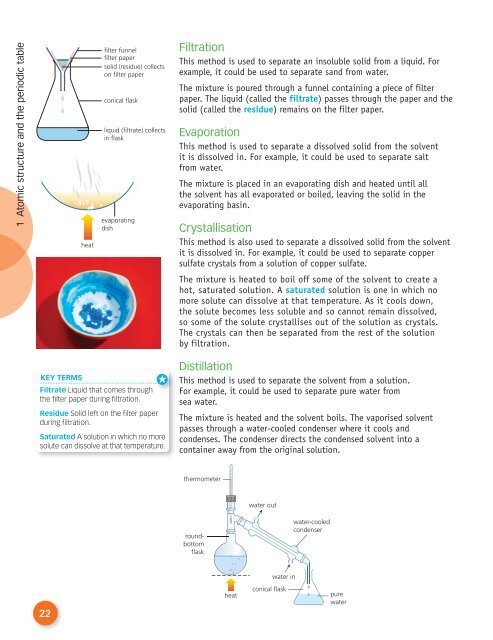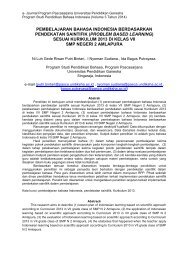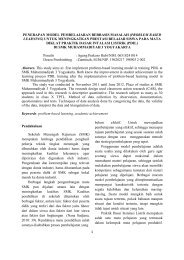Create successful ePaper yourself
Turn your PDF publications into a flip-book with our unique Google optimized e-Paper software.
1 Atomic structure and the periodic table<br />
heat<br />
filter funnel<br />
filter paper<br />
solid (residue) collects<br />
on filter paper<br />
conical flask<br />
liquid (filtrate) collects<br />
in flask<br />
evaporating<br />
dish<br />
Filtration<br />
This method is used to separate an insoluble solid from a liquid. For<br />
example, it could be used to separate sand from water.<br />
The mixture is poured through a funnel containing a piece of filter<br />
paper. The liquid (called the filtrate) passes through the paper and the<br />
solid (called the residue) remains on the filter paper.<br />
Evaporation<br />
This method is used to separate a dissolved solid from the solvent<br />
it is dissolved in. For example, it could be used to separate salt<br />
from water.<br />
The mixture is placed in an evaporating dish and heated until all<br />
the solvent has all evaporated or boiled, leaving the solid in the<br />
evaporating basin.<br />
Crystallisation<br />
This method is also used to separate a dissolved solid from the solvent<br />
it is dissolved in. For example, it could be used to separate copper<br />
sulfate crystals from a solution of copper sulfate.<br />
The mixture is heated to boil off some of the solvent to create a<br />
hot, saturated solution. A saturated solution is one in which no<br />
more solute can dissolve at that temperature. As it cools down,<br />
the solute becomes less soluble and so cannot remain dissolved,<br />
so some of the solute crystallises out of the solution as crystals.<br />
The crystals can then be separated from the rest of the solution<br />
by filtration.<br />
KEY TERMS<br />
Filtrate Liquid that comes through<br />
the filter paper during filtration.<br />
Residue Solid left on the filter paper<br />
during filtration.<br />
Saturated A solution in which no more<br />
solute can dissolve at that temperature.<br />
Distillation<br />
This method is used to separate the solvent from a solution.<br />
For example, it could be used to separate pure water from<br />
sea water.<br />
The mixture is heated and the solvent boils. The vaporised solvent<br />
passes through a water-cooled condenser where it cools and<br />
condenses. The condenser directs the condensed solvent into a<br />
container away from the original solution.<br />
thermometer<br />
water out<br />
roundbottom<br />
flask<br />
water-cooled<br />
condenser<br />
water in<br />
22<br />
heat<br />
conical flask<br />
pure<br />
water





